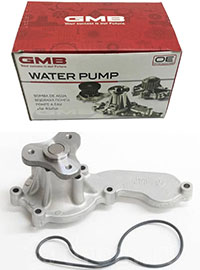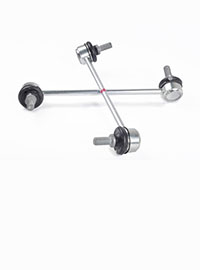-20%
Get Stabilizer link 48820-47010
Stabilizer links, also known as sway bar links or anti-roll bar links, are components of a vehicle’s suspension system designed to connect the sway bar (or anti-roll bar) to the suspension. Here’s a definition and overview of stabilizer links:
Definition of Stabilizer Links:
Stabilizer links are mechanical linkages that connect the ends of the sway bar (or anti-roll bar) to the suspension components, typically the control arms or struts. They are usually constructed of metal rods with ball joints or bushings at each end.
Benefits;
1. Enhanced Stability and Handling
- Reduced Body Roll: Stabilizer links help to minimize body roll or sway during cornering, providing a more stable and predictable ride. This is especially important when driving through curves, bends, or uneven terrain.
- Improved Cornering Performance: By keeping the vehicle’s body level, stabilizer links enhance cornering grip, allowing for better control and a smoother driving experience. This contributes to more precise steering response and better overall handling.
2. Increased Driver and Passenger Comfort
- Smoother Ride Quality: By reducing the amount of sway and oscillation experienced during turns, stabilizer links contribute to a smoother and more comfortable ride. This is beneficial for reducing the impact of road imperfections on passengers.
- Minimized Vibrations: Stabilizer links absorb some of the forces exerted on the suspension, reducing the vibrations and harshness transmitted through the chassis and into the cabin.
3. Improved Safety
- Enhanced Vehicle Control: Stabilizer links are critical for maintaining optimal tire contact with the road during cornering. This enhances traction and stability, reducing the risk of skidding or loss of control, especially in emergency maneuvers.
- Prevention of Understeer and Oversteer: Properly functioning stabilizer links help prevent understeer (when the vehicle turns less than desired) and oversteer (when the vehicle turns more than desired), enhancing overall vehicle stability and control.
4. Extended Suspension Life
- Reduced Wear and Tear: By stabilizing the vehicle’s body during turns, stabilizer links reduce the stress and strain on other suspension components, such as shocks, struts, and bushings. This helps extend the lifespan of these components.
- Consistent Performance: Maintaining the integrity of the stabilizer links ensures that the suspension system operates efficiently, reducing the likelihood of premature wear or failure of related suspension parts.
5. Better Vehicle Dynamics
- Balanced Handling Characteristics: Stabilizer links help maintain a balanced distribution of weight across the suspension, enhancing the vehicle’s dynamics and ensuring that all four wheels maintain consistent contact with the ground.
- Optimized Suspension Geometry: By stabilizing the suspension movement, stabilizer links help maintain the correct suspension geometry, ensuring that the tires maintain optimal alignment and contact with the road surface.
6. Enhanced Driving Confidence
- Predictable Handling: With stable and responsive handling characteristics, drivers can navigate corners and changes in direction with greater confidence, knowing that the vehicle will respond predictably to their inputs.
- Reduced Steering Effort: Improved stability and reduced body roll can also make steering feel lighter and more precise, enhancing the overall driving experience.
7. Maintenance and Cost Efficiency
- Easy Maintenance: Stabilizer links are generally straightforward to inspect and replace, making routine maintenance simpler and more cost-effective. Regular checks can help catch wear early, preventing more significant issues down the line.
- Cost Savings: By preventing excessive wear on other suspension components, stabilizer links contribute to lower long-term maintenance costs. They help ensure that the entire suspension system operates efficiently, reducing the need for frequent repairs.
Signs of a worn out Stabilizer Link;
1. Clunking or Rattling Noise
- Audible Signs: A noticeable clunking, rattling, or knocking noise coming from the front or rear suspension when driving over bumps or uneven road surfaces.
- Testing: You may hear the noise more prominently when driving at low speeds or when going over speed bumps. It can indicate that the ball joints or bushings within the stabilizer links have worn out.
2. Looseness or Excessive Play
- Movement Test: With the vehicle parked and engine off, manually check the stabilizer links by attempting to move them up and down or side to side.
- Excessive Movement: If there is significant play or looseness in the stabilizer links, particularly at the joints or bushings, it indicates wear and potential failure.
3. Steering and Handling Issues
- Increased Body Roll: Worn stabilizer links may result in increased body roll during cornering or swaying of the vehicle when changing lanes at higher speeds.
- Reduced Stability: You may notice a decrease in overall stability and control, especially when navigating curves or turns, as the stabilizer links are less effective in stabilizing the vehicle.
4. Uneven Tire Wear
- Tire Inspection: Check the tires for uneven wear patterns, particularly on the edges of the tread.
- Cause: Worn stabilizer links can lead to improper alignment or suspension geometry, causing the tires to wear unevenly and reducing their lifespan.
5. Vibration or Steering Wheel Play
- Steering Feedback: Experiencing vibrations or shaking through the steering wheel, especially when driving at higher speeds.
- Play in Steering: Increased play or looseness in the steering wheel, where the vehicle feels less responsive to steering inputs, can also indicate issues with stabilizer links affecting alignment.
6. Grease Leakage or Visible Damage
- Inspection: Check the stabilizer links for signs of grease leakage around the joints or bushings.
- Visible Damage: Look for cracks, tears, or visible damage to the rubber boots, as this can indicate wear and potential failure of the stabilizer links.
7. Vehicle Age and Mileage
- Maintenance Schedule: Consider the age and mileage of the vehicle, as stabilizer links may wear out over time due to regular use and exposure to road conditions.
- Replacement Interval: If the stabilizer links have not been replaced within the manufacturer’s recommended intervals or if the vehicle has been driven on rough roads, they may be due for inspection and potential replacement.
8. Steering Alignment Issues
- Off-Center Steering Wheel: An off-center steering wheel position when driving straight is a sign of misalignment, potentially caused by worn stabilizer links affecting suspension geometric.
Follow us on Facebook For more parts.



